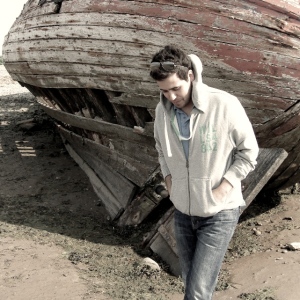July 29, 2012 · 10:29 am
I have been featuring fantastic female fantasy authors (see disclaimer) but this has morphed into interesting people in the speculative fiction world. Today I’ve invited the talented Jason Nahrung to drop by.
 Jason will be in South East Queensland for the launch of his book, Salvage, soon. In the meantime, look out for the give-away at the end of the post.
Jason will be in South East Queensland for the launch of his book, Salvage, soon. In the meantime, look out for the give-away at the end of the post.
Q: Your novella Salvage, is coming out through Twelfth Planet Press. This is set in remote Queensland and has dark undertones. How do you bring darkness to sunny QLD and why did this story come to you in novella length?
 Indeed, Salvage is available now, and I’m running some celebratory events in Queensland in August to support it (Brisbane launch. The novella was a gradually developed story – I’ve explored the slightly unusual process at my blog that came from both time and place: three writing retreats across three years, all at the same location on Bribie Island. That might’ve helped determine the length, in that I wrote about a third of the story in each retreat, and then polished it. I did wonder about expanding it into a novel-length piece – novellas aren’t the most popular format, although that does seem to be changing in line with the e-revolution – but the story is complete at this length, just under 40,000 words: why add to it unnecessarily in the pursuit of some perception of making it more marketable?
Indeed, Salvage is available now, and I’m running some celebratory events in Queensland in August to support it (Brisbane launch. The novella was a gradually developed story – I’ve explored the slightly unusual process at my blog that came from both time and place: three writing retreats across three years, all at the same location on Bribie Island. That might’ve helped determine the length, in that I wrote about a third of the story in each retreat, and then polished it. I did wonder about expanding it into a novel-length piece – novellas aren’t the most popular format, although that does seem to be changing in line with the e-revolution – but the story is complete at this length, just under 40,000 words: why add to it unnecessarily in the pursuit of some perception of making it more marketable?
One of the reasons I began to write with a view to publication was a yearning to see the kinds of stories I loved – speculative fiction of all stripes – set in my own backyard. Why did all the aliens land in the US? Why do the English and the Americans get to go off-world? It’s been most gratifying to see the likes of Trent Jamieson and Stephen M Irwin selling their Australian-set – Brisbane-set, no less – novels overseas, with no questions asked.
Queensland, for all its beach stereotypes, has plenty of darkness, as Trent and Stephen have shown: urban back streets, rural isolation, baking plains, choking forests. The beach has its own dangers, too: sunburn, rips, sharks and stingers. True, the Gothic mode that I love so much is an awkward fit: no misty moors nor crumbling castles, for instance, but I think mirage-haunted clay pans and abandoned homesteads work just as well, especially given our own colonial unease within the landscape. The Gothic is about mood, about the uneasy past and fragile emotions, and those kinds of influences can work in most settings. At the end of the day, horror is about people: they fall short in all climates.
In Salvage, the beach is an unlikely setting for a vampire story, but I think it works thanks to that very contrast. The landscape is a limiting, isolating factor; it mirrors the threat facing the characters. And the sea is a wonderful metaphor for immortality and hunger. The vampire ecology is always demanding; in Salvage, I’ve made my own changes and taken a subtle approach: the word vampire is never used, for instance.
Q: I met Jason through the Vision Writers Group and we both did our Masters through QUT. At that time Jason was writing a book about Kev, the Vampire, transplanting the vampire mythology to an Australian setting. When I told my kids the title and the concept, they wanted to read the book. Did you eventually finish the book, Jason? Or have you moved on and put it aside until you work out how you want to tackle the concept?
Ah, dear Kev. His story’s been with me for more than 10 years – a chapter, long since discarded, was the first thing I took to the Vision writers group – and has been through four distinct iterations as I’ve tried to find the right format, the right narrative, the right characters to tell the story … and finally, I’ve done it! Called Blood and Dust, the novel will be out later this year in digital format through Sydney publisher Xoum.
Q: As I recall part of your Masters was an examination of the vampire in Australian fiction. (See here for pre 2007 OZ vampire stories, and here for Oz vampire stories post 2006). I notice there are a lot more stories, post 2006. Can you give us a glimpse of what conclusions you came to with your research?
I confess I haven’t done a good job of keeping up with Aussie vampire fiction since I finished the Masters, and there is certainly a lot of it out there. The pleasing thing, for me, is that there seems to be less disinclination to set it in Australia. I suspect cultural cringe was as much an issue as narrative concerns: a lot of the early fiction was set overseas or in geographically neutral settings. Sure, we’re a sunburnt land, but we’re also highly urbanised and geographically isolated both as an island and internally as a large land mass. Writers have increasingly seized on those characteristics, looked at how our colonial past and our successive waves of migration have opened the doors to the Gothic, and how to fit those tropes into the sprawl of modern-day Australian society. A very good example of the diversity is Dead Red Heart, an anthology of Australian vampire stories published last year by Ticonderoga Publications that covers the gamut: colonial, indigenous, outback, urban, rainforest and more.

Kirstyn and Jason (courtesy Cat Sparks)
Q: Your partner, Kirstyn McDermott, is a fellow writer of dark fiction. Do you find this is a plus having a partner who is a fellow writer? Have you collaborated? Or do you find you can’t show each other work-in-progress because you feel too naked?
It’s a lot of fun having another writer in the house. We have conversations about semi-colons and exclamation marks, for instance; we discuss the structure of our stories, plot sticking points, character headaches, moral issues. We read each other’s work, usually once the first draft is finished, and offer feedback, and then will proofread as well. Plus, it’s nice to not feel guilty about spending time with the people in my head rather than my wife, knowing that she’s doing the same thing!
We haven’t collaborated yet, but it’s something we’d like to do in the future. We have different writing processes that should dovetail quite well. I tend not to show anyone my work in progress because it’s all fairly malleable; I have to write the story to know what the story is about, then go back and do a lot of rewriting to get it into shape Kirstyn lands her words on the page pretty much in final form, having spent a lot of time internalising and then shaping on the page during that first draft.
Q: The road to publication is rocky. Back in 2007 your book, The Darkness Within, was chosen by Hachette to launch a new line. Not long after this the line closed down and you were ‘orphaned’. What advice can you offer to fellow writers who find themselves in this position?
 The Darkness Within did have a rocky start: it was picked up by Lothian as part of a new series of adult horror novels, but Lothian was bought by another company, and that company was bought by Hachette, all in short order. Hachette broke The Darkness Within out of the series and upscaled it to a trade paperback, which to be honest I never think is helpful for an unknown debut trying to compete against established authors in cheaper paperback. We did get good inclusion in catalogues and wide distribution – and a gorgeous cover!
The Darkness Within did have a rocky start: it was picked up by Lothian as part of a new series of adult horror novels, but Lothian was bought by another company, and that company was bought by Hachette, all in short order. Hachette broke The Darkness Within out of the series and upscaled it to a trade paperback, which to be honest I never think is helpful for an unknown debut trying to compete against established authors in cheaper paperback. We did get good inclusion in catalogues and wide distribution – and a gorgeous cover!
I guess how you react to changes at that industry level is in part determined by how much control of your product you’ve got. I know some authors have been able to buy their books back to avoid having them dumped on the market, devoid of love or promotion, by an unsympathetic publisher looking to change direction and cut losses. Otherwise, you just have to do your damndest to promote the title, and make sure you get those rights back as soon as your contract allows so you can leverage that title in the future.
Q: I notice that The Darkness Within was sold as both horror and crime. Where do you think the divide exists, or have we reached a point where there is no divide in the genres?
I’m not sure where the crime angle came into it – it was quite weird to see it pop up on crime websites, and I imagine anyone reading it based on that presence would’ve been bitterly disappointed. Certainly, the boundaries between genres is increasingly porous – crime and horror do go together very well, and we’ve got crime blending with fantasy and science fiction; period pieces and romance adapting horror monster tropes for their own purpose; alt history using science fiction and fantasy.
The boundaries are imposed by purists and traditionalists, and to some extent by marketers trying to work out which shelf – or which meta tags – to use. The biggest divide appears to be between capital L literature, where the prose is still king, and the more narratively driven genres; between attempts to distinguish between good and bad writing, between art and commercial fiction. The fact that you find few genre authors – YA is a possible exception, its umbrella term enclosing such a wonderful diversity of genres from contemporary lit through to the wonderfully fantastic – at mainstream literary festivals illustrates that divide, I think; it’ll be interesting to see the support for GenreCon in Sydney in November, which seeks to embrace all branches of genre. Now that could be a fascinating melting pot of approaches and ideas!
I consider Salvage to be a cross-genre story: part horror/thriller, part romance, part contemporary lit. It’s made promotion a little awkward, because I don’t think it quite fits neatly into any of those categories, but draws on tropes from all of them to tell its story. There are no genre holds barred when it comes to servicing Story. If only there was a shelf for that.

Q: In 2005 you won the William Atheling JR Award for a piece you had published in the Courier-Mail, Why are Publishers Afraid of Horror? Is it possible to read this article? What did you have to say in it?
It is: the Australian Horror Writers Association has archived it at here.
The piece surveyed a number of writers about the genre’s standing in the Australian publishing landscape, and found little support for it in the mainstream, apparently still haunted by the pulp that came out in the 1980s. The trend, which is still continuing, was for stories that might’ve been categorised as horror, particularly of the non-creature variety, to be brought out as general literature. The horror title was eschewed because of its slasher and pulp overtones; dark fantasy was on the rise as a more palatable alternative, but even that had its limitations.
It’s worth pointing out that print on demand and digital publishing, both in e-book and online format, have helped change the landscape since the article was published; there are a bunch of small press concerns happy to fly the horror flag.
Q: You are currently editing the QWC newsletter. What fiction are you working on?
Last year was a bumper year for me in terms of short fiction, but that has dried up this year. I think that’s a function of managing paid employment, lifestyle and creative thinking space. I’m concentrating on a sequel to Blood and Dust: I’ve spent the past three months trying to imagine the story, and actually do some plotting, and now it’s time to start writing my way into the story. Exciting, frustrating times!
Q: I hear you’re flying up from Melbourne for a tour of South east Queensland. If librarians and writing groups would like to contact you for a talk, what do they do?
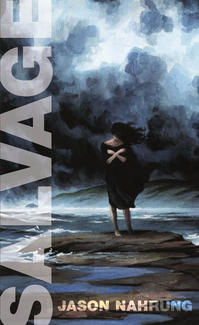 I’m looking forward to returning to my home state with Salvage — the story was written on Bribie Island, after all! I’m launching the book at Avid Reader on August 10 with the wonderful Kim Wilkins doing the honours. The next day, I’m joining my fellow writers from the dark side Kirstyn McDermott and Angela Slatter to discuss horror and dark fiction at the Logan North library as part of their excellent SF Month line-up. And then on Monday August 13 I’m presenting a talk about Salvage, vampires and writing — all that good stuff! — at Caloundra library, then backing up at the Noosa library on the 14th. The support from the libraries has been awesome. Full details on when, where and how to RSVP are at my website, and my contact details are there, too.
I’m looking forward to returning to my home state with Salvage — the story was written on Bribie Island, after all! I’m launching the book at Avid Reader on August 10 with the wonderful Kim Wilkins doing the honours. The next day, I’m joining my fellow writers from the dark side Kirstyn McDermott and Angela Slatter to discuss horror and dark fiction at the Logan North library as part of their excellent SF Month line-up. And then on Monday August 13 I’m presenting a talk about Salvage, vampires and writing — all that good stuff! — at Caloundra library, then backing up at the Noosa library on the 14th. The support from the libraries has been awesome. Full details on when, where and how to RSVP are at my website, and my contact details are there, too.
Q: I was prompted to start this series of interviews because there seems to be a perception in the US and the UK that fantasy is a bit of a boy’s club. Do you think there’s a difference in the way males and females write fantasy?
I don’t think that perception holds much currency in Australia, which is what has made your series so interesting to follow. And fantasy is such a massive label, isn’t it? I don’t think I can say I’ve noticed a peculiar gender approach in what I’ve been reading; admittedly, I’ve been reading a lot of fiction by women, due in part to the Australian Women Writers Challenge. One thing that irritates me in any story is the presentation of women as some kind of cookie cutout: the trophy, the sack of raw emotions, the sex object, etc; I think that’s mostly a boy thing because the trope is easier than providing a well-rounded character.
Q: Following on from that, does the gender of the writer change your expectations when you pick up their book?
It doesn’t; the combination of cover art and back cover blurb set my expectations. The only gender expectation I’ve noticed is that, in a first person account, the narrator has the same sex as the author until proven otherwise. I don’t know why that bias occurs, but it’s caught me out a few times.
Q: And here’s the fun question. If you could book a trip on a time machine, where and when would you go, and why?
Manchester, 1979. To see Joy Division in full flight.
Jason has a copy of his new novella Salvage to give-away.
Giveaway Question: What is your favourite vampire character in a movie or book?
Catch up with Jason on Facebook
Catch up with Jason on Goodreads
Follow Jason on Twitter @JNahrung
Catch up with Jason on his blog
See here for a list of Jason’s books and short stories
Filed under Australian Writers, Dark Urban Fantasy, Fantasy books, Gender Issues, Publishing Industry
Tagged as Dark Fantasy, horror writers, Jason Nahrung, Kirstyn McDermott, Slavage, The Darkness Within, Twelfth Planet Press
July 25, 2012 · 12:32 pm
I have been featuring fantastic female fantasy authors (see disclaimer) but this has morphed into interesting people in the speculative fiction world. Today I’ve invited the talented Lee Battersby to drop by.
Look out for the give-away at the end of the post.
Q: You’ve had over 70 short stories published, won the Aurealis Award, Australian Shadows Award (twice) and won an International Writers of the Future competition. Prime books published a collection of your short stories called Through Soft Air. Do you think the discipline of writing short fiction, helped hone your skill for novel writing?
 I think my short story writing experience helped when it came to building scenes and establishing coherent lines of narrative, but I found the shift from writing the short to long form a bit dislocating in many ways. I’d probably become too entrenched in the short form way of thinking, and had to leave a lot of shorthand habits behind. It’s still a bit of a wrench to write long establishing scenes, for example, and I still absolutely hate writing long descriptions of landscape or setting—short story thinking demands I get to the bloody point now, dammit! One thing I do enjoy when writing novels is the opportunity to write increasingly complex streams of dialogue: I like the narrative cut and thrust of spoken wordplay, and the way you can reveal and hide information simultaneously. In short stories you use dialogue to reveal the narrative a little more quickly. In novels, you can be a bit richer.
I think my short story writing experience helped when it came to building scenes and establishing coherent lines of narrative, but I found the shift from writing the short to long form a bit dislocating in many ways. I’d probably become too entrenched in the short form way of thinking, and had to leave a lot of shorthand habits behind. It’s still a bit of a wrench to write long establishing scenes, for example, and I still absolutely hate writing long descriptions of landscape or setting—short story thinking demands I get to the bloody point now, dammit! One thing I do enjoy when writing novels is the opportunity to write increasingly complex streams of dialogue: I like the narrative cut and thrust of spoken wordplay, and the way you can reveal and hide information simultaneously. In short stories you use dialogue to reveal the narrative a little more quickly. In novels, you can be a bit richer.
I’ve written in a myriad of forms over the years: stage plays, TV scripts, stand-up comedy, poetry… each form comes with its own rules and ways to break them, and I think the more forms you work in, the better you’re able to adapt to new disciplines. The important thing is not to become hide-bound by one form. I’ve produced the best short stories of my career over the last couple of years, without a great deal of market impact, so I’m making the transition to novels at the right time. I could have done so a couple of years ago and been a bit further along in my career plans, perhaps, but the Angry Robot Open Door success came along at exactly the necessary moment.
Q: You wrote a post for the ROR blog where you described the rollercoaster of submitting to the Angry Robot Open Submission Month. (994 manuscripts). And now your book The Corpse Rat King has been published. (Mega congratulations!) If you could go back and give yourself some advice when you submitted that manuscript, what would it be?
Not a single thing: the novel got through the process, it was picked up, I gots me an agent. I think it pretty much ticked all the boxes!
I was fortunate in that I submitted as a reasonably experienced author, so I knew not to hang about waiting for something to happen. I was already writing another novel—I had 52k of it under my belt before the contract was signed—and was working on a bunch of other stuff while I waited. So I was quite happy with the way the whole submission process panned out: I’d been a bit moribund beforehand but it revitalised me, and got me thinking of my career in different terms, which has been refreshing.
Q: The sequel to The Corpse Rat King, Marching Dead, is due out in 2013. Has it been a very different process writing a sequel, while editing the first book? And do you have an idea for a third book in the series?
 It has been different, in that I’m working to a deadline, as well as not being in the position where I can make up characters and locations from scratch. In a sense I’m much less free than I was in writing the first volume. Characters are established, distances are established, locations and levels of technology are all established. I can’t just make stuff up as I go along, so if I’ve cocked something up in creating the first book then I have to work with it and make it acceptable. That said, of course, I’m able to allow my characters to grow to a much greater extent, so it’s a lot of fun answering questions that may have arisen in volume one. And there are a few revelations along the way, too: the advantage of not working to a plan is that I can be surprised by something that pops up unbidden in the first draft and then, by the time the final draft is finished, make it look like I intended that to happen all along .
It has been different, in that I’m working to a deadline, as well as not being in the position where I can make up characters and locations from scratch. In a sense I’m much less free than I was in writing the first volume. Characters are established, distances are established, locations and levels of technology are all established. I can’t just make stuff up as I go along, so if I’ve cocked something up in creating the first book then I have to work with it and make it acceptable. That said, of course, I’m able to allow my characters to grow to a much greater extent, so it’s a lot of fun answering questions that may have arisen in volume one. And there are a few revelations along the way, too: the advantage of not working to a plan is that I can be surprised by something that pops up unbidden in the first draft and then, by the time the final draft is finished, make it look like I intended that to happen all along .
I do have a story arc worked out for the 3rd book, just in case the first two do well and Angry Robot decide to commission a third. I know the beginning, and the end point, and the Great Big Decision ™ Marius will have to make in order to reach it. Any more than that will generally work itself out in the writing. But it would be fair to say that any shit my heroes managed to pour all over themselves in the first two books would be nothing when compared to volume three!
Q: You have tutored at Clarion South and you have an article on the Australian Horror Writers Association web site Industry Advice. The industry is changing so fast. Once it was the kiss of death to self-publish, now many authors are self-publishing their back lists. Do you find yourself scrambling to keep up?
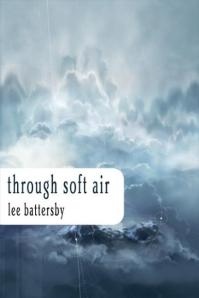 I’m not a big fan of self-publishing new pieces: to my old-fashioned way of thinking it still carries the whiff of work not good enough to attract a more traditional publisher. However, I can understand why an author who has the time and energy to do so would want to release older pieces directly to the public without any intermediary: the work has already undergone a process of third-party quality control, the dialogue between author and reader can be made more immediate, and the cash flows more directly to the writer.
I’m not a big fan of self-publishing new pieces: to my old-fashioned way of thinking it still carries the whiff of work not good enough to attract a more traditional publisher. However, I can understand why an author who has the time and energy to do so would want to release older pieces directly to the public without any intermediary: the work has already undergone a process of third-party quality control, the dialogue between author and reader can be made more immediate, and the cash flows more directly to the writer.
I readily acknowledge that I’m a little bit behind the times in my thinking: I still adhere to a traditional publishing model for my work, and I’m comfortable with that. I see a number of authors putting their own work out via electronic self-publishing, and it seems to me a very labour intensive way to go about your business. But when it comes to the marketplace, authors have to understand that they are small business owners, and as a small business owner, you have to decide the best way to market your product and how much time you’re willing to spend in developing the means of production. My instinct has always been that I’m too time-poor to be an effective electronic self-pubber, so I’ve steered away from it: I’m not passionate about that process, I’m not an adherent of the delivery system (I don’t own an e-reader, I don’t plan to own one, etc.), and for me, what time I do have is better utilised in other ways. That’s no comment on those who do choose to go down that track, just a fairly honest assessment of where my own strengths and weaknesses lie.
Ultimately, the best delivery medium, and the way you promote and market yourself as an author, is decided by the overall goals you have for your career. Self-publishing doesn’t attract me because it doesn’t fit in with my strengths and it doesn’t align with the direction I want my career to take. I keep in touch with the discussions, because I think every writer should be at least passingly familiar with the trends and evolutions of their business environment. But my limited experience shows me two levels of work being pushed—electronic reprints of paper books, which any sensible author should be pursuing as a negotiable clause in their contracts anyway, and original e-only works: the literary equivalent of a straight-to-video release, with the accompanying wild variations in quality. And I’m not sure I’ve discovered an efficient-enough means of separating the wheat from the chaff to make jumping into that second category a time-effective way to spend my writing career.
There may come a time when I look at self-publishing my story backlist, but truth be told I’d be just as comfortable with a small press publisher swooping in and offering to do all the hard business stuff for me in return for a cut of the proceeds, or paying me a flat fee as per the traditional business model. That might mean a cut in my potential in-hand profit, but I make a good living so money’s not that much of an issue, and at the end of the day I like real, hold-‘em-in-your-hand dead tree books, so it’s a compromise I’m happy to make.
Q: Your wife is talented writer, Lyn Battersby. With two creative people, who happen to be creative in the same medium in the same house, do you find this is a blessing or a curse? Do you read each other’s work and give feedback? Or do you find you can’t bear to do this? Have you considered collaborating? (eg. Written by L & L Battersby).

Lyn and Lee (courtesy Cat Sparks)
Lyn and I have collaborated on one story: a post-alien invasion tale called ‘C’ that, for a number of reasons, never really satisfied either of us so never saw the light of day. We’re both gearing up to work more as full-time novelists now, so the chances of collaboration on a fiction project aren’t high. Lyn writes much more elegant and subtle prose than I do, and her subject matter tends to be far more intimate, so I think there’s probably a clash in approach that doesn’t benefit our respective strengths. Once she gets the recognition her work deserves she’s going to become far too rich and famous to suffer having me riding her coat-tails, anyway…
But it’s definitely more a blessing than a curse to be married to someone with the same career goals and aspirations, simply because of the level of understanding. One of us can call ‘writing night’ at any time and there’s no argument, and when we talk it’s in the same language. We did read each other’s work a lot more when we were less experienced, mainly, I think, as a form of reinforcement that what we were doing made sense to someone else. Now we’re fairly confident in our own abilities we tend to read each other for pleasure, and Lyn doesn’t read my long work—she wants to wait for it to come out in proper novel format. But we’re always on hand to offer instant advice or an opinion, and as we generally can’t stop talking about current projects we usually have a pretty good idea what each other is working on, where we’re at with it, where it’s going, how rich it’s going to make us… just normal, everyday, married person conversations .
Q: I was prompted to start this series of interviews because there seems to be a perception in the US and the UK that fantasy is a bit of a boy’s club. Do you think there’s a difference in the way males and females write fantasy?
It’s a gross generalization to split a literary genre along gender lines, but I think you could argue that there are differences in the way males and females perceive fantasy, inasmuch as we seem to fantasize for different reasons. We’re a fairly small outpost in Australia, and I think it’s probably a bit easier to do a head-count than in the larger markets, so we’ve got a pretty good idea of our gender mix, which is increasingly healthy if not yet equitable. It helps to have good, strong publishers who understand the need for variation in theme and approach: in particular, Twelfth Planet Press and Fablecroft Publishing are two houses that are helmed by smart, high-quality editor/publishers who strive to promote a more literate, intelligent type of fantasy, which is the sort of environment where subtler forms of writing can thrive.
I think the male/female style argument is a somewhat simplistic one, and I’d like to think that as an industry we might have become a little more sophisticated than that, at least here in Australia, because I can see the Australian SF small press working hard to provide opportunities based on idea and theme rather than gender alignment, but as I said, it’s easier to look at the demographic in its entirety here, and also easy to view things from the perspective of a white middle-class male with few barriers to his career. My wife, who writes beautifully subtle and elegant works that often don’t pass through the quick-read filter, might gently intimate that I’m talking shit.
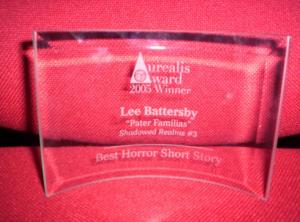 Q: Following on from that, does the gender of the writer change your expectations when you pick up their book?
Q: Following on from that, does the gender of the writer change your expectations when you pick up their book?
Not a bit. I’m utterly disinterested in the gender of the author when I pick up a book. Gender is just a description of where your dangly bits dangle from. It’s not an expression of sexual orientation, political affiliation, socio-economic outlook, or any of the umpty million psychological, societal and environmental factors that an author brings to their work. It may inform some of those factors, but what’s more interesting, from a creative point of view, is your overall worldview: the set of experiences that you, as a writer, translate into fiction. Gender is by no means the deciding, or even major, element in the translation of that mindset.
As a reader, and as simplistic as it sounds, all I want is to read a good book. That’s it. I don’t care if the author is an ancient Sumerian rabbit god with a lisp, as long as the story they tell moves me, involves me, and just maybe, leaves me looking at the world through a different lens. I’m old enough to have grown up whilst it was still relatively easy to find Leigh Brackett, CL Moore, Julian May and the likes on a shelf. And whilst it was—and remains—a blight on the industry that a significant percentage of writers feel they have to conceal their gender in order to find an audience, from the perspective of my young reader-self it meant that, as I grew up, I paid attention to the name on the cover rather than the identity of the author behind them. I’ve no doubt that gender plays a part in the publishing business, which would lead me down a very different rant indeed, but once a book actually reaches the bookshelf, the gender of the author becomes a non-issue for me.
Ultimately, if the gender of the author is the sole reason you pick up a book—or worse, the reason you don’t—then you may be missing the fucking point a wee bit. Is my experience of, say, a George Eliot novel lessened because I might learn that Oor George was a woman? Could I be that simplistic a creature? And if I am, what the fuck do I do if someone hands me a Caitlin Kiernan book, or a Poppy Brite?
A book is a doorway to a shared experience, and if you’re lucky, an experience that you not only haven’t had before but could not conceive of having. If reading that book leads you to seek out information about the author, and if learning about their lives enriches your reading experience, then fantastic. But the book itself is the gift. The story within is the sole point of contact through which we, as readers, have the right to critique and analyse the author’s motive. Anything else, unless directly communicated by the author, is conjecture. To take the immortal Trillian entirely out of context: anything you still can’t cope with is, therefore, your own problem.
As an author, though, as an author: that’s a different bucket of cows. The truth is, at least within our beloved little genre, that SF remains the province of a largely masculine way of thinking, and what’s worse; it’s a masculine way of thinking that even Tony Abbott might occasionally find old-fashioned and bigoted. It is undeniably a struggle to pass a truly feminine, or transgendered, worldview through the gatekeepers of most magazines and publishers. From an editing point of view—particularly in the magazine field—we’re set up for the quick fix. It’s easier to filter for a muscular, action-driven narrative that responds well to a first reading than it is to reward a subtle, emotionally-shaded, character-driven narrative that needs two or three readings to fully unfold. To split such stories directly down that divide as typically male or female is, of course, a gross simplification in itself, but as Westerners we create a societal culture that demands women define themselves as emotional beings, and then create a genre infrastructure that makes it difficult to sell emotionally subtle stories. Is it any wonder that female authors who have the greatest success writing Spec-style novels have a tendency to either do it outside the genre or loudly disassociate themselves from it?
Of course, all comments can be filtered through my happy life as a fat, middle-class white man, and disregarded as necessary.
Q: And here’s the fun question. If you could book a trip on a time machine, where and when would you go, and why?
I’m having a hard time not hearing Kryten right now: “If I could go anywhere, absolutely anywhere at all in time, I think I’d probably choose to go back to a week last Tuesday… I did all the laundry, and then we watched TV. Wow, we won’t see the like of THOSE sorts of days again.” 🙂
Dinosaurs. It’s got to be dinosaurs. Because, well… dinosaurs!
Giveaway Question: “If you could go anywhere after you die, where would it be?”
Catch up with Lee on Facebook
Catch up with Lee on Goodreads
Catch up with Lee on Google+
Follow Lee on Twitter @leebattersby
Catch up with Lee on Linkedin
Lee’s Blog
Filed under Australian Writers, Book Giveaway, creativity, Dark Urban Fantasy, Fantasy books, Gender Issues, Publishing Industry, Tips for Developing Artists
Tagged as Angry Robot, Book Giveaway, Fantasy books, Lee Battersby, The Corpse Rat King, Writing craft
July 14, 2012 · 11:29 am
I’m expanding my series featuring fantastic authors to include fantastically creative people across the different mediums, which is why I’ve invited the talented Queenie Chan to drop by.
There are links to give-aways sprinkled throughout the interview.
Q: In the Eighties I lived in Melbourne and knew a bunch of comic artists. One of the things I noticed was that they would be obsessed with art work, the look, the over-all layout of the page, but story would fall by the wayside. On your website you say: ‘After all, the essence of manga is not so much the art, but the story-telling, themes and pacing. These three are what you should concentrate on when trying to tell a story — any story, not just manga.’ Have you always been fascinated by story? Did your parents read to you? When you saw a movie, did you imagine what happened to the characters afterwards?
 Oh, that sounds real interesting! You sound like you met a lot of interesting people when you lived in Melbourne (I must say, I did too when I lived there for a year). Anyway, you’re right about the many different camps of people who read graphic novels – some are all about the art, others are all about the story, while yet more believe in a combination of both. Personally, I’ve always felt that story is more important than art – a story can’t be expressed properly if the art is inadequate, but I also have seen a lot of well-drawn manga/comics that are dull and boring despite beautiful, realistic renderings. I still feel that to work in any storytelling medium (which comics is), your first duty is to engage the reader’s attention in whatever the purpose of the medium is for, so if it’s comics, it should be story.
Oh, that sounds real interesting! You sound like you met a lot of interesting people when you lived in Melbourne (I must say, I did too when I lived there for a year). Anyway, you’re right about the many different camps of people who read graphic novels – some are all about the art, others are all about the story, while yet more believe in a combination of both. Personally, I’ve always felt that story is more important than art – a story can’t be expressed properly if the art is inadequate, but I also have seen a lot of well-drawn manga/comics that are dull and boring despite beautiful, realistic renderings. I still feel that to work in any storytelling medium (which comics is), your first duty is to engage the reader’s attention in whatever the purpose of the medium is for, so if it’s comics, it should be story.
So yes, I’ve always been more fascinated by story, and as you said, I like to imagine the continuation of stories after they’ve “officially” finished. My parents encouraged me to read as a child, but they never read to me much (neither read fiction, to be honest), and so I got my fix from a variety of different sources – books, movies, TV series, cartoons, manga and video games. Even as a child, I was always writing fan-fiction in my head based on my favourite TV shows.
Q: You say you plot the story, concentrating on the beginning and end and often let the middle take care of itself. And that: ‘In longer stories … there is time to set the characters free in the world you’ve created, and watching them interact with each other and with the environment. If your characters are well-constructed, then they would behave accordingly, and sometimes in ways completely unexpected to you.’ At this stage are you still brainstorming the story flow in a sentence or two, or do you actually start to draw and find the characters doing unexpected things?
 Since I’m a comic book writer/artist, the way I work is quite different to prose authors. I’m not saying I’m representative of comic book writers or artists in general, but most people who work in the comic medium are often constrained by the number of pages available. So in my case, the first thing I do when brainstorming is to figure out how many pages a story can be, because if a story becomes too long, it may be impossible to draw (since it will be impossible to finish).
Since I’m a comic book writer/artist, the way I work is quite different to prose authors. I’m not saying I’m representative of comic book writers or artists in general, but most people who work in the comic medium are often constrained by the number of pages available. So in my case, the first thing I do when brainstorming is to figure out how many pages a story can be, because if a story becomes too long, it may be impossible to draw (since it will be impossible to finish).
With prose, you can always add paragraphs or sentences and rewrite things if you want, but unfortunately with comics, once you’ve set something down on paper, it can be very hard to change. You can’t add an extra two panels to page 26 of your page 170 book (so far) if you want to – it will mess up the panel flows for the rest of the book. Because of this, my brainstorming usually involves writing down what happens on page 1, then what happens on page 2, and continuing by making a page-by-page summary of what happens on each page.
This part isn’t hard, but sticking to it isn’t always easy. Things always change when you go from prose to images, so you have to accommodate having to insert extra pages in when you start drawing the comic. Other times you’ll have to shorten scenes or extend them, so these days, I always make sure I have a good “feel” of the story in my head before I draw anything. As I said, the longer your story, the more freedom you have in letting your characters have their character moments. You may find a scene play out different as you draw it than you originally imagined, but the overall arc of the story shouldn’t deviate from the plan too much.
Q: You say you consider yourself: ‘… a Citizen of The World.’ You were born in Hong Kong and came to Australia when you were six. Did you live in a multicultural suburb where you mixed with people from a lot of different backgrounds or was this interest in other societies just something that you uncovered as you came across books and movies from other cultures?
 I grew up in a very multi-cultural suburb alright – I went to school with all sorts of interesting people and it was always lovely to learn about other cultures! I was always very interested in travelling, and not necessarily to other Anglophone cultures. As a child, I wanted to go to Africa, to the Middle East and to India, because I thought of these places as exotic, and with a long history.
I grew up in a very multi-cultural suburb alright – I went to school with all sorts of interesting people and it was always lovely to learn about other cultures! I was always very interested in travelling, and not necessarily to other Anglophone cultures. As a child, I wanted to go to Africa, to the Middle East and to India, because I thought of these places as exotic, and with a long history.
I think being a history buff helps a lot too. I read a fair amount about Ancient History, and it’s always been a kind of dream for me to visit those historic places that I’ve read so much about.
Q: You say: ‘The reason why I’m so interested in interlocking story threads has a lot to do with my interest in human nature, sociology and anthropology. One of the things I find infinitely fascinating about genre-based story-telling in general is the environment the story is set in, and how that influences the character’s morals, values and actions.’ This is where I come from when writing my own books. I like to put my characters in situations that make them confront what they believe. You’ve made me want to run out and buy some of your books now. Was there a particular writer/movie director/artist whose mastery of character and setting made you think, Wow, that is what I’d like to do, but in my own way?
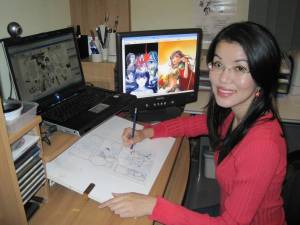 Ah, nice to know we share that point-of-view in common! I think fantasy can get a bad rep amongst some circles, because people tend to think they know what fantasy is without having read any of it (D&D, girls in metal bikinis swinging swords at orcs). The truth is, fantasy is just anything that isn’t set in this world, but set in a different world; a world which has social conventions similar to our own. What better way is there to explore human nature, without all the political, racial, cultural and historical baggage that each one of us accumulates in this world, just by virtue of living in it? As you said, putting your characters in situations that make them confront their beliefs is what people in this world do every day, just as they do in the worlds you create in your novels.
Ah, nice to know we share that point-of-view in common! I think fantasy can get a bad rep amongst some circles, because people tend to think they know what fantasy is without having read any of it (D&D, girls in metal bikinis swinging swords at orcs). The truth is, fantasy is just anything that isn’t set in this world, but set in a different world; a world which has social conventions similar to our own. What better way is there to explore human nature, without all the political, racial, cultural and historical baggage that each one of us accumulates in this world, just by virtue of living in it? As you said, putting your characters in situations that make them confront their beliefs is what people in this world do every day, just as they do in the worlds you create in your novels.
As for people who have inspired me… there’s been far too many to list. I can point out one man in particular who set me on my path – Tezuka Osamu, the creator of Astro Boy. He was a thoroughly-entertaining manga artist, but also a great humanist, and I encountered his series Black Jack at a particular time in my life (I was 15) which left a deep impression on me. Black Jack is about a rogue doctor who charges exorbitant fees for his services, but he’s also a very good doctor who understands that some people have illnesses that have nothing to do with the physical. The ethical questions that crop up in that manga is quite interesting.
Q: From reading the blurb about The Dreaming it seems to have the feel of the movie Picnic at Hanging Rock, which had a lyrical dreamlike quality about it, and to also be a modern take on the Gothic Romance Literature. Are these two sources which might have influenced you subconsciously as you were creating this story?
Picnic at Hanging Rock was definitely the biggest inspiration for The Dreaming, and you’re right about the gothic literature influences. Rebecca by Daphne DuMaurier was the other big influence, as were movies like Rosemary’s Baby. The visual aspect was quite important for me (namely the way the school looked), but I think I wanted to create a more modern, “haunted-school” take on the whole Picnic at Hanging Rock mythos, so the story ended up bearing hardly any resemblance to any of these three books/movies. Which is a good thing. Even if you can name all your influences, it’s a pleasure to know that what you created is unique in its own way.
By the way, I have the first 2 volumes (of 3) of The Dreaming online as a free webcomic.

Q: Your chapter dividers in The Dreaming remind me a little of the black & white work of Arthur Rackham and perhaps Art Nouveau (Mucha). Do you have heaps of books on art?

Actually, I don’t have many artbooks, especially compared to other comic book artists. I’m not really big on art at all. As I mentioned before, I’m more interested in story-telling than I am in art, so people are often aghast when it turns out that I haven’t heard of [insert name of famous illustrator here]. It’s assumed that all people who draw must be big fans of the art world, but unfortunately… I’m not.
I really do like Mucha’s art style, though it wasn’t something I’ve discovered until recently. And while I love what I’ve seen of Arthur Rackham’s artwork (google images, yay!), I actually think that the chapter divider art for “The Dreaming” looks more like some of Gustav Klimt’s line artwork (that I randomly saw in a book somewhere). I must say that I wasn’t influenced by any particular artist when I drew those chapter dividers – Klimt’s work was something I encountered afterwards.
 Q: With the Odd Thomas Series (stories originally by Dean Koontz), did Koontz see your work and ask you to illustrate his stories, or were the pair of you matched up by his/your publisher? (Reading your blog post about it, I see it was a little bit of both). So I’ll come up with another question. How is the movie project going?
Q: With the Odd Thomas Series (stories originally by Dean Koontz), did Koontz see your work and ask you to illustrate his stories, or were the pair of you matched up by his/your publisher? (Reading your blog post about it, I see it was a little bit of both). So I’ll come up with another question. How is the movie project going?
I believe we were matched up by our publisher Del Rey, though ofcourse, Dean has to like my work to begin with. I’m not sure what work he has seen of mine before we started working together, but we’ve had a good working relationship thus far, and it would be an honour if we did more books together. As of now, there’s three Odd Thomas books (In Odd We Trust, Odd Is On Our Side, and House of Odd), and I’m happy with how things are.
I believe the movie for Odd Thomas has been completed, and is looking for distribution. I don’t really know much about it, I’m afraid, since this is a project that is driven mostly by Dean. When it comes out, I’m sure all the Odd Thomas fans will run out to see it!

Q: A while ago at Supanova Kylie Chan pulled out some of your artwork and showed me. She’s so proud of the work you’re doing on Small Shen. Were you already one of Kylie’s readers? How did the two of you connect?
(Update Small Shen isi finished!)
Kylie approached me at GenCon a few years ago, and introduced herself and her novels. I didn’t really know of her or her work beforehand, but it was rare to see Chinese Fantasy be so successful, so I took an interest in her work. When I contacted Kylie, it turns out that she had a prequel to her series called Small Shen, and wanted to do something “graphic-novelly” with it. Since I relish the chance to draw some Chinese-style fantasy artwork, I decided to take on the project. That was how it all got off the ground!

It’s been fun working on this project, and I’m nearing the end. This has been a special book, because this is a book that mixes prose with comics, and is not a straight-forward graphic novel. It’s experimental, but so far it’s working out quite well, so I look forward to it coming out in Xmas 2012 from Harper Collins.
Here’s an interview Oz Comic Con did with Queenie about her Small Shen project with fantasy author, Kylie Chan (no relation), among other things.
[youtube=http://www.youtube.com/watch?feature=player_embedded&v=x7qNQ2ryrds]
Q: I was prompted to start this series of interviews because there seems to be a perception in the US and the UK that fantasy (in books) is a bit of a boy’s club. I’ve come across quite a bit of talk on the blogs recently about female comic artists and writers, and their lack of representation in large companies like DC. Have you come across this in your professional life?
 I think this perception exists throughout a lot of pop culture. Even when talking about books, there’s a perception that sci-fi, horror, crime, thriller, literary, etc are all male-dominated. The only thing that is seen as exclusively female is probably chic-lit or romance – but even then, these books are packaged in such a female-oriented way that any chance of them appealing to a male audience is pretty much dead due to the deluge of pink covers. Meanwhile, there are a large number of successful female authors working across the genres, and there always has been.
I think this perception exists throughout a lot of pop culture. Even when talking about books, there’s a perception that sci-fi, horror, crime, thriller, literary, etc are all male-dominated. The only thing that is seen as exclusively female is probably chic-lit or romance – but even then, these books are packaged in such a female-oriented way that any chance of them appealing to a male audience is pretty much dead due to the deluge of pink covers. Meanwhile, there are a large number of successful female authors working across the genres, and there always has been.
Things are pretty much the same in the comics industry. While it’s true that companies like DC and Marvel dominate (and they are largely male-oriented), there are many female comic book artists out there who don’t work in superheroes, and are just doing their own thing. I’m one of them.
It’s true that there are a lot of assumptions being made by people outside the industry, though, and even inside the industry. Many comics industry blogs tend to cover only superheroes, and hardly any other kind of comic. If you’re going to focus on one small part of the comics industry, then yes, you’re going to get a skewed perception of gender.
Q: Following on from that, does the gender of the writer/artist change your expectations when you approach their work?
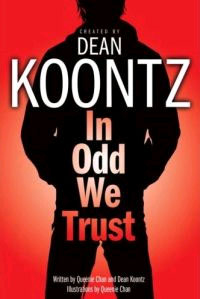 No, it doesn’t. I think a good writer is a good writer, and I don’t think the gender of the writer has any effect on the final work. Male and female writers may be interested in different things, or approach things from other angles, but a good story told well is exactly that, and all that’s left is accounting for differing tastes.
No, it doesn’t. I think a good writer is a good writer, and I don’t think the gender of the writer has any effect on the final work. Male and female writers may be interested in different things, or approach things from other angles, but a good story told well is exactly that, and all that’s left is accounting for differing tastes.
I think things are a little different for artists though. If you’re talking about artists who are paired up with writers, then it rests on the skill of the artist to tell the writer’s story effectively, and sometimes they don’t do that. However, that’s got nothing to do with gender though – it’s more to do with what genre that artist is used to working in. If an artist is flexible, they ought to know how to adapt themselves to different genres. If they don’t, and they believe that one-art-style-fits-all… then it can get a little awkward.
Q: And here’s the fun question. If you could book a trip on a time machine, where and when would you go, and why?
Ah, that’s a hard question. My answer can change each time someone asks me that question, depending on what I’m into at that particular point in time. Previously I said just after the meteor that destroyed the dinosaurs hit, so I can see the terrible global destruction that it must have caused (but I would probably die very quickly from it). But as of now, I may just take the easy route and travel to Ancient Egypt to watch them build the Pyramids and raise the Obelisk. I have a theory as to how they raised the Obelisk, and am wondering whether it checks out with history.
Queenie’s Blog.
Catch up with Queenie on Facebook
Filed under Australian Artists, Australian Writers, Book Giveaway, Comics/Graphic Novels, Conferences and Conventions, Conventions, creativity, Gender Issues, Genre, Publishing Industry, Story Arc, Tips for Developing Artists, Writers Working Across Mediums
Tagged as Astro Boy, Australian comic artists, Dean Koontz, Kylie Chan, Manga, Odd Thomas, Queenie Chan, Small Shen, The Dreaming
July 11, 2012 · 9:07 am

Bruce with Apple Blossom (1977)
I have been featuring fantastic female fantasy authors (see disclaimer) but this has morphed into interesting people in the speculative fiction world. Today I’ve invited the hardworking and insightful Bruce Gillespie to drop by.
I first met Bruce in 1976, when I went to Melbourne with Paul Collins to start an Indie Press publishing house. Bruce was living in Carlton with his cat Flodnap (and his cat’s cat, Julius) and had been editing fanzines for 8 years. By 1976, Bruce had been nominated for a Hugo three times, so despite being only 29, he was already one of the Grand Old Men of Australian SF Fandom.
Q: Your work had received three Hugo Nominations before you were 30. You have received total of 45 Ditmar Nominations and 19 wins, and The A Bertram Chandler Award in 2007, plus you were fan guest of honour at AussieCon 3, the World SF Convention in 1999, is there anything left that you would like to achieve?
 A: Like any other fanzine editor or writer, I would actually like to win the Hugo Award for either Best Fanzine or Best Fan Writer! But that seems impossible these days, since even in 1999 and 2010, when the world convention was held in Australia, I could not gain enough votes to reach the nominations list.
A: Like any other fanzine editor or writer, I would actually like to win the Hugo Award for either Best Fanzine or Best Fan Writer! But that seems impossible these days, since even in 1999 and 2010, when the world convention was held in Australia, I could not gain enough votes to reach the nominations list.
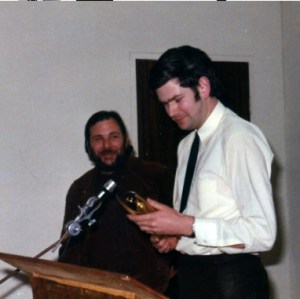
Bruce receives his first Ditmar from John Bangsund (1972)
However, in 2009 I was awarded the Best Fan Writer in the annual FAAN Awards, given by my peers, the fanzine writers and editors who attend the Corflu convention in America. I count that as a great honour, along with having received Australia’s two awards for lifetime achievement, the A. Bertram Chandler Award (as you mention) and the Peter MacNamara Award. In practical
terms, the greatest honour I’ve received was the Bring Bruce Bayside fan fund, which enabled me to return to America (for the Corflu and Potlatch conventions) for a month in 2005.

- The Gang (1967)
John Bangsund, Leigh Edmonds, Lee Harding, John Foyster, Tony Thomas, Merv Binns and Paul J Stevens
- The Gang (1967)
Q: In your 2012 snapshot interview you say: A fanzine is a minor artform, based on putting together a wide range of material from my favourite writers, plus response from letter writers from all over the world. The use of a computer limits the artform in some ways, but also offers design, editing and font possibilities that were impossible to access in the Good Old Days (pre 1990s) of using stencils and duplicators.’ You have been producing zines now since 1968, that’s 44 years. In that time you must have worked out what makes a good fanzine. If you could go back now to Bruce circa 1968, what advice would you give him?
 A: I could have warned him not to use the typewriter with which I produced the first SF Commentary in 1969. It was a little Olivetti with a beautiful typewriter face — but unfortunately it would not cut a stencil properly. For a fanzine that was almost illegible, SF Commentary No 1 gained an enormous response from people around the world, including a letter from Philip K. Dick, my favourite SF writer.
A: I could have warned him not to use the typewriter with which I produced the first SF Commentary in 1969. It was a little Olivetti with a beautiful typewriter face — but unfortunately it would not cut a stencil properly. For a fanzine that was almost illegible, SF Commentary No 1 gained an enormous response from people around the world, including a letter from Philip K. Dick, my favourite SF writer.
But apart from that, how can you give advice to a 22-year-old, especially someone with far more energy than I have now? ‘Follow your nose?’ ‘Never give up?’ I knew then that no matter how people responded to my fanzines, that was what I should be doing. Nothing’s changed.

Bruce with Brian Aldiss at Stone henge (1974)
Q: In the same interview you said: ‘Of course, I can publish electronically, using PDF files, on Bill Burns’ wonderful efanzines.com, but I know that many people download such magazines and don’t read them with the attention they would devote to a magazine they received through the mail.’ I do most of my reading on-line, following science blogs, political activists and researching. Personally, I don’t feel that I give less attention to my on-line reading. What leads you to believe that an on-line magazine is valued less than a print magazine?
A: For someone of my generation, a paper document has real existence, and online documents don’t. I don’t really believe that the current electronic publications will be available or readable in twenty years, let alone forty, but I still own almost all the paper fanzines I’ve received since 1969. If I value anything I find Out There, I copy it into a Word file and print it. More to the point, many of my correspondents say that they reply to paper fanzines, and don’t respond to fanzines posted on efanzines.com. That’s if they even take the trouble to download.
The current situation is that I can no longer afford to print and post my fanzines, so I will be asking almost all my readers to download them. This will sharply reduce the number of letters of comment I receive, but it gives me much more freedom to publish much more often.
Q: You once said about Fandom: ‘Before I joined fandom I had almost no friends or anybody with whom I could share my interests. In fandom I found people who were not just another part of the mundane world, which I find stifling. During a weekend I spent at Lee Harding’s place in late 1967, I met for the first time many of the people who have had the most influence on my life, such as John Bangsund, Lee Harding, George Turner, John Foyster and Rob Gerrand.’ (See Bruce’s post about science fiction and fandom here). I must admit that it wasn’t until I came to Melbourne with Paul in 1976 that I met people I could talk to. I’d come from Brisbane where all people talked about was football and getting drunk (obviously I was moving in the wrong circles). In Melbourne fandom I met fascinating people who could hold stimulating conversations on all manner of topics. I felt like I’d come ‘home’. Nowadays with the WWW people can make contact with other like-minded people, but forty years ago it was much harder. SF fans were considered extremely odd. Can you give readers a glimpse of what it was like to be a fan in those days?

Melbourne Fandom in 1954
Back row: Merv Binns, and Dick Jenssen
Front row: Bob McCubbin, Bert Chandler and Race Mathews
A: At school, I had only two friends who read science fiction at all. Nobody else I knew read SF, although the SF magazines were much more widely available (in newsagents) than now. At university, no other students seemed interested. However, I did read in the Bulletin in 1966 that Melbourne had just held an SF convention. Charles Higham wrote what remains the fairest report any Australian journalist has ever offered of an SF convention. He made it sound very exciting. I also knew that the Melbourne SF Club held its meetings every Wednesday night in Somerset Place, which was behind McGill’s Newsagency in Elizabeth Street. McGill’s had the only good stock of science fiction in Melbourne, and I realised that this had something to do with the tall thin man who loomed behind the counter (who was, of course, Mervyn Binns, who has just been given the Infinity Award for his services to fandom). Every science fiction book sold in McGill’s included a little leaflet advertising the club. Also, McGill’s sold a magazine called Australian Science Fiction Review (ASFR). The quality of the reviews and articles in this magazine were staggeringly far ahead of those in the pro SF magazines, for both intellectual content and sparkling style. However, I knew I would never finish my degree if I became involved in fandom from 1965 to 1967. At the end of 1967 I wrote several articles on the works of Philip K. Dick and sent them to John Bangsund, the editor of ASFR. He rang me in December 1967 and suggested I visit his home in Ferntree Gully to meet the people who produced the magazine. This was the beginning of my career in fandom, for I met people who read what I read, talked about what interested me, and who were interested in what I had already written.

Bruce with Allan Sandercock (1971)
Q: You are a qualified school teacher and did teach for two years, but gave it up to produce fanzines and write about speculative fiction. You said: ‘My mundane career has never gone anywhere much, and I’ve often been nearly broke. But my career in fandom (as an editor), which has never made me any money, has led to most of the good things in my life.’ What do you think are essential traits an editor needs?
A: That’s not quite right. I gave up teaching because I was hopeless at it. I was very close to suicide at the end of 1970, but a friend prompted me to do what I would have thought unthinkable — resign. When I did this, the Department wanted to keep teachers, so I was offered a series of bribes to stay officially a teacher. The last of these was a position in the Publications Branch of the Department. In 1971 and 1972 I received a full on-the-job training in professional editing and journalism. I left in mid 1973 to go overseas, visiting fans all over America for four months and a month in Britain. When I returned I decided to try freelance book editing. I knew there was no editing work in SF in Australia, but my friend John Bangsund was making an intermittent living from freelancing, and there was plenty of work, especially in textbooks, in 1974.
The essential quality of an editor is to love correcting other people’s writing. You trawl through a book and can see how you can improve it. Many editors (especially my wife Elaine) are much better at it (are much more meticulous) than I am, but I’ve kept on working over the years, sometimes successfully (as during the twelve years I received guaranteed freelance work from Macmillan in Melbourne) and sometimes disastrously (such as at the end of 1976, when I was actually forced to take a part-time office job for a year or so). Elaine and I have learned to skate along from cheque to cheque, and sometimes those cheques are very thin on the ground.

Bruce Gillespie and Elaine Cochrane on their Wedding Day (1979)
Q: In 1979 along with Carey Handfield and Rob Gerrand, you were one of the founding editors of Norstrilia Press, which published Greg Egan’s first novel, among others. Was there are particular philosophy that the three of you developed when you started Nostrilia Press?

Dick Jenssen and Rob Gerrand (2005)

Bruce Gillespie and Carey Handfield (1975)
A: Like the other small presses of the time, including Cory & Collins and Hyland House, our aim was to publish material that no major publisher would touch. You might remember that during 1973, for instance, there were 17 novels of any genre published by all Australian publishers. Even after the Australia Council began its publishing program under the Whitlam Labor Government, most of the spate of new titles sprang from the small press enterprises, such as Outback Press.
Carey said that the aim of Norstrilia Press (named in honour of American writer Cordwainer Smith, who had a great love of Australia, and whose only novel was Norstrilia) was to return enough money to SF Commentary, my magazine, to keep it going. This never happened, of course, but our first book (1975) was a set of essays called Philip K. Dick: Electric Shepherd. All the material, which included essays by Stanislaw Lem and George Turner, came from SF Commentary.

Carey devised a complicated system by which individual fans invested in particular books that we published. Since eventually we had to provide a return on investment, we diversified quickly. (Our only other critical book was The Stellar Gauge, essays by the finest critics in the field, edited by Michael Tolley and Kirpal Singh in 1981).
 Our second book was The Altered I, with stories and essays based on the Ursula Le Guin Writers Workshop of 1975 (held in association with Australia’s first world convention, Aussiecon 1).
Our second book was The Altered I, with stories and essays based on the Ursula Le Guin Writers Workshop of 1975 (held in association with Australia’s first world convention, Aussiecon 1).
We tracked down a novel by Keith Antill called Moon in the Ground. It had won a prize several years before, but had never found a publisher.
Greg Egan sent us his An Unusual Angle, a brilliant novel he had written when he was seventeen.
I had met Gerald Murnane at Publications Branch, and had typed several of his novels before he learned to type. In 1977 I suggested that one section of a giant novel would make a great book on its own. That became The Plains in 1982, which was our greatest success (gaining a nomination for The Age Book of the Year Award), and still Gerald’s best regarded book. Text Publishing has just produced yet another edition, and it has had several overseas editions.
We were also very pleased to publish George Turner’s literary memoir In the Heart or in the Head, as well as The View from the Edge, his book about the 1977 Writers Workshop held at Monash University.
However, all of Carey’s and Rob’s labours were unpaid, and I was paid only for the typesetting work that I did for Norstrilia Press, Cory & Collins and Hyland House. At the end of ten years, we had made very little money, and Carey wanted to get married and establish his own career. So Norstrilia Press finished in 1985.

John Foyster, Carey Handfield, Damien Broderick and John Bangsund (1982)
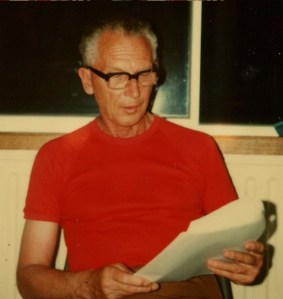
George Turner (1979)
Q: You are the executor for George Turner’s literary estate. What exactly does being a Literary Executor entail?
A: Not a lot, because George has not exactly been popular since his death in 1997. His main audience was overseas, and all those editions have gone out of print. Most of the work in keeping his name alive has been done by his agent, now my agent, Cherry Weiner, an Australian who has lived near New York for many years. At various times she has had great success with various Australian authors, such as Keith Taylor, Wynne Whiteford, David Lake, and now Paul Collins. She sold George’s posthumous novel Down There in Darkness, in 1998, but little since. I’ve signed contracts for Gollancz in Britain to republish The Sea and Summer (Drowning Towers in USA) as an SF Masterwork. I’m hoping that when it appears, it will re-establish George Turner as one of the major SF talents of the last fifty years.
I did publish 100,000 words of George Turner’s non-fiction as SF Commentary 76. Copies are still available, both as download and as a paper magazine.

Aussice Con 3 Timebinders Panel (1999)
Q: I was prompted to start this series of interviews because there seems to be a perception in the US and the UK that fantasy and particularly SF is a bit of a boy’s club. Do you think there’s a difference in the way males and females write?
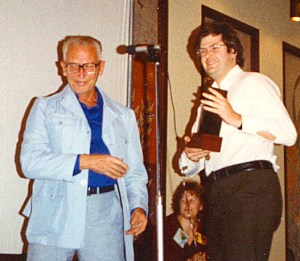
Bruce receives a Ditmar from George Turner (1980s)
A: Are we talking about science fiction or fantasy? To me they are quite different fields, with fantasy dealing with impossible events; and SF, at its best, being realistic novels that happen to be set in the future, rather than in the present or the past.
And are we talking about the writers or the readers? The balance in the composition of the readership changed very rapidly. When I became involved in SF fandom, the only women who turned up at conventions and club meetings were girlfriends or wives or members. That’s in 1968 and 1969. This began to change rapidly after 1971, mainly because of the influx of younger female media fans, but also a lot of women who were just beginning their careers as academics, teachers and librarians. By the 1973 Easter convention held in Melbourne, nearly half of the attendees were women, and that balance has remained even ever since.
But Australian writers, who were mainly male (Damien Broderick, Lee Harding, David Boutland, Jack Wodhams and Wynne Whiteford) tended to huddle in corners in the early 1970s because there were very few of them. There had been a very famous Australian female writer, Norma Hemming, but she had died in 1960 when she was very young. Cherry Wilder lived in Sydney for awhile, but she was a New Zealander with a German husband, so she went to live in Germany in the late 1970s.
The balance changed after fantasy became the dominant publishing genre in Australia in the 1990s. When HarperVoyager began consciously to recruit Australian writers, they found a treasure trove of young, enthusiastic women writers who have become very popular. Science fiction almost disappeared here, except from a few (male) writers such as Sean William, Sean McMullen and Terry Dowling. Marianne de Pierres and Lucy Sussex seem to be our only female writers who publish mainly science fiction.
All you have to do is look around at any fannish or professional gathering in Australia to see that 80 per cent or more of our writers are now female. They include many of my own favourite dark fantasy writers, such as Kaaron Warren, Cat Sparks and Deb Biancotti. I don’t read three-parter blockbuster medieval fantasy novels myself, but I acknowledge that Australia’s female writers (as well as a few males, such as Garth Nix) have conquered the field.
Q: Following on from that, does the gender of the writer change your expectations when you pick up their book?

Bruce receives the Chandler award from Paul Collins and Kirstyn McDermott (2011)
A: I’m only interested in finding good writing. I can’t help sympathising with Gerald Murnane’s rather provocative statement that no book should be published with the name of the author visible. In other words, the prose should speak for itself. Aesthetics über alles. However, like most readers I’m curious the find out about the authors whose works I enjoyed most, and I can’t help being flattered if my favourite writers remember something I might have written about their work. But I admit that most of my favourite SF writers have been male, for example, Philip Dick, Brian Aldiss, Thomas M. Disch, Cordwainer Smith, George Turner, Wilson Tucker, Stanislaw Lem and Christopher Priest. I always buy every new book by Ursula Le Guin. I love Joanna Russ’s work, but her novels were not as interesting as her short stories. I’ve enjoyed some of Gwyneth Jones’ books, but not all. In literary fantasy, nothing beats Le Guin’s Earthsea series and Diana Wynne Jones’s novels, but I also love fantasy by Peter Beagle, Italo Calvino, Steven Millhauser and a whole lot of others.
Q: And here’s the fun question. If you could book a trip on a time machine, where and when would you go, and why?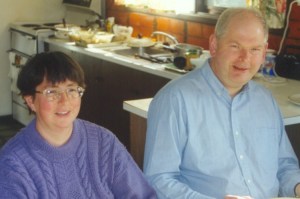
A: As the Strugatsky Brothers reminded us in their fun novel, Hard to Be a God, any of us would find any past era very smelly and very dangerous. Given the right inoculations (and nose filters), I would like to investigate the period that the Steampunkers have adopted as theirs, that very exciting era of huge change from 1880 to 1914. You would have to think that the First World War was staged to destroy that tremendous fizz of progressive thinking and scientific and artistic change that seemed likely to lead to a brave new world. How were they were to know in 1914 that millions would be killed, and that Stalin and Hitler would divide the world’s attention for the next thirty years?
For a list of Bruce’s publications and essays see here.
For Bruce’s listing on the e-fanzine site, with links to all his fanzines, see here.
 Jason will be in South East Queensland for the launch of his book, Salvage, soon. In the meantime, look out for the give-away at the end of the post.
Jason will be in South East Queensland for the launch of his book, Salvage, soon. In the meantime, look out for the give-away at the end of the post. Indeed, Salvage is available now, and I’m running some celebratory events in Queensland in August to support it (Brisbane launch. The novella was a gradually developed story – I’ve explored the slightly unusual process at my blog that came from both time and place: three writing retreats across three years, all at the same location on Bribie Island. That might’ve helped determine the length, in that I wrote about a third of the story in each retreat, and then polished it. I did wonder about expanding it into a novel-length piece – novellas aren’t the most popular format, although that does seem to be changing in line with the e-revolution – but the story is complete at this length, just under 40,000 words: why add to it unnecessarily in the pursuit of some perception of making it more marketable?
Indeed, Salvage is available now, and I’m running some celebratory events in Queensland in August to support it (Brisbane launch. The novella was a gradually developed story – I’ve explored the slightly unusual process at my blog that came from both time and place: three writing retreats across three years, all at the same location on Bribie Island. That might’ve helped determine the length, in that I wrote about a third of the story in each retreat, and then polished it. I did wonder about expanding it into a novel-length piece – novellas aren’t the most popular format, although that does seem to be changing in line with the e-revolution – but the story is complete at this length, just under 40,000 words: why add to it unnecessarily in the pursuit of some perception of making it more marketable? The Darkness Within did have a rocky start: it was picked up by Lothian as part of a new series of adult horror novels, but Lothian was bought by another company, and that company was bought by Hachette, all in short order. Hachette broke The Darkness Within out of the series and upscaled it to a trade paperback, which to be honest I never think is helpful for an unknown debut trying to compete against established authors in cheaper paperback. We did get good inclusion in catalogues and wide distribution – and a gorgeous cover!
The Darkness Within did have a rocky start: it was picked up by Lothian as part of a new series of adult horror novels, but Lothian was bought by another company, and that company was bought by Hachette, all in short order. Hachette broke The Darkness Within out of the series and upscaled it to a trade paperback, which to be honest I never think is helpful for an unknown debut trying to compete against established authors in cheaper paperback. We did get good inclusion in catalogues and wide distribution – and a gorgeous cover! I’m looking forward to returning to my home state with Salvage — the story was written on Bribie Island, after all! I’m launching the book at Avid Reader on August 10 with the wonderful Kim Wilkins doing the honours. The next day, I’m joining my fellow writers from the dark side Kirstyn McDermott and Angela Slatter to discuss horror and dark fiction at the Logan North library as part of their excellent SF Month line-up. And then on Monday August 13 I’m presenting a talk about Salvage, vampires and writing — all that good stuff! — at Caloundra library, then backing up at the Noosa library on the 14th. The support from the libraries has been awesome. Full details on when, where and how to RSVP are at my website, and my contact details are there, too.
I’m looking forward to returning to my home state with Salvage — the story was written on Bribie Island, after all! I’m launching the book at Avid Reader on August 10 with the wonderful Kim Wilkins doing the honours. The next day, I’m joining my fellow writers from the dark side Kirstyn McDermott and Angela Slatter to discuss horror and dark fiction at the Logan North library as part of their excellent SF Month line-up. And then on Monday August 13 I’m presenting a talk about Salvage, vampires and writing — all that good stuff! — at Caloundra library, then backing up at the Noosa library on the 14th. The support from the libraries has been awesome. Full details on when, where and how to RSVP are at my website, and my contact details are there, too.












































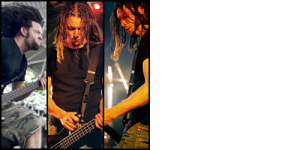
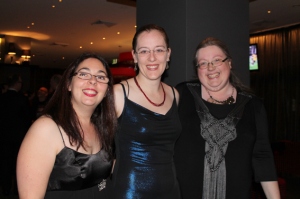
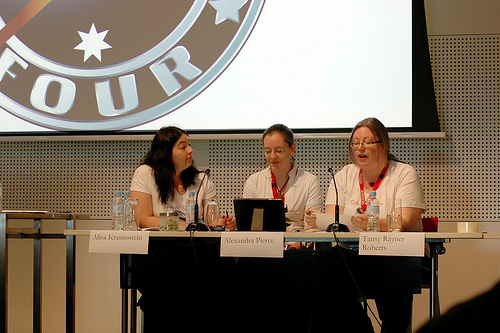

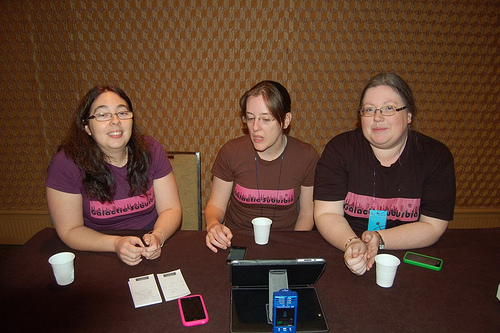








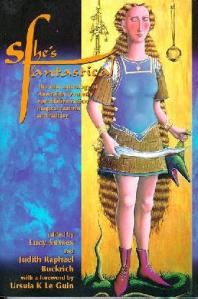





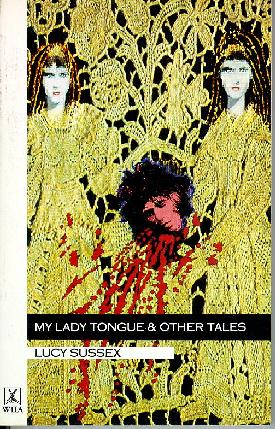
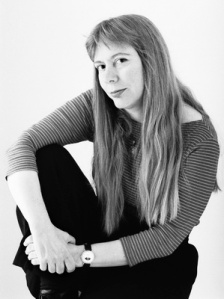





![Newton-CityOfRuinPBUK[3]](http://writersagainstobscurity.files.wordpress.com/2011/11/newton-cityofruinpbuk3.jpg)
